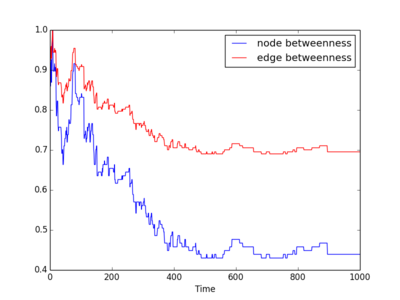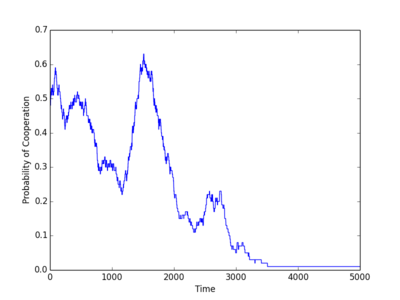Multiplex Networks: Difference between revisions
From Santa Fe Institute Events Wiki
No edit summary |
|||
| Line 113: | Line 113: | ||
== Results == | == Results == | ||
'''Changes in the average node betweenness and edge betweenness centrality measures'''<br> | |||
This example shows the we can measure structural properties of the network as it undergoes perturbations. <br> | |||
[[File:betweennessPerturbation.png|400px]] | |||
'''Changes in the number of cooperators as the nodes play games'''<br> | |||
This example shows the we can calculate a measure of dynamics of the process running of the network.<br> | |||
[[File:pdf1.png|400px]] | |||
Revision as of 16:41, 18 June 2014
Outcomes of first meeting
(1) We develop several cases where multiplex networks can help illuminate dynamics that cannot be studied using a single network
(a) Tax game, we need to talk more about payoffs and strategies.
(b) Why Stalin went after friends and family of potential enemies? He recognized that informal networks matter
(c) Dynamics of decision making and conflict resolution in firms and other organizations
(d) We need some cases from ecology?
(2) We divided into two groups: Modeling and Content The content group has to come up with ideas on what to model, in particular what is meaningful for each domain and what is meaningful across domain. They need to do some literature review, perhaps even find data that related to Multiplex networks. Who is coordinating this group?
The modeling groups needs to talk some code from C++ to Python, perhaps make agents thicker,i.e. given them ability to do something. They also need to figure out a GUI that can be used by people who do not want to go into the code to change things. Ali is coordinating this group.
(3) The sub-groups may meet more often, the large group will meet next on Wednesday
Next Meeting: Wedn,18th time 1:30 PM, same place as last meeting
Agenda for Meeting
(1) CONTENT group: what does mean multiplex in your domain? a. What does multiplex network mean in different disciplines? b. What are meaningful games in different disciplines? c. What are meaningful strategies in different disciplines?
(2) MODELLING group: modelling thinking.
Next Meeting: Wedn, 25th time TBA, same place as last meeting
Agenda for Meeting
(1) CONTENT group: literature review
(2) MODELLING group: first draft of general model
GROUPs
CONTENT: Brais Cecilia Francesca Sanja
MODELLING: Alireza Alberto Cecilia Francesca Massimo Vipin
- For those missing the Sunday meeting, please allocate yourself in one of the two groups.
QUESTIONS
(1) How to apply game theory tools in ecological network?
(2) What is happening inside each node and in each link?
Data set
http://esapubs.org/archive/ecol/E092/066/default.htm
http://ecologicaldata.org/find-data
Multiplex Networks in Ecology
References:
A colonization-extinction 'game' on an ecological multiplex network (trophic & dispersal interactions):
Pillai et al. 2011
How including different interaction types changes ecological dynamics:
Allesina and Tang 2012
Sauve et al. 2013
Multiplex Networks for Game Theory
References:
Evolution of Cooperation in Multiplex Networks
http://www.ncbi.nlm.nih.gov/pmc/articles/PMC3431544/
Ecological Networks
File:Pocock etal 2012 Network of Ecological Networks Robustness & Restoration.pdf
Misc. References
Software
Existing Features (1) Generic Network structure: complex node objects and complex edges (2) node and edge attributes may change over time according to some rule (3) asynchronous update for edge and node attributes (4) Fermi update rule for playing pairwise games on each layer of network and changing strategies.
To be added (1) synchronous update (2) other update rules (3) various specific networks structures
Results
Changes in the average node betweenness and edge betweenness centrality measures
This example shows the we can measure structural properties of the network as it undergoes perturbations.

Changes in the number of cooperators as the nodes play games
This example shows the we can calculate a measure of dynamics of the process running of the network.

